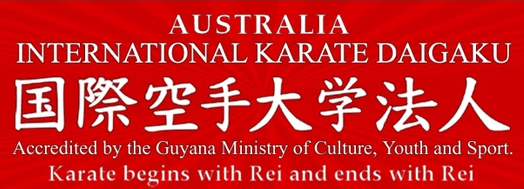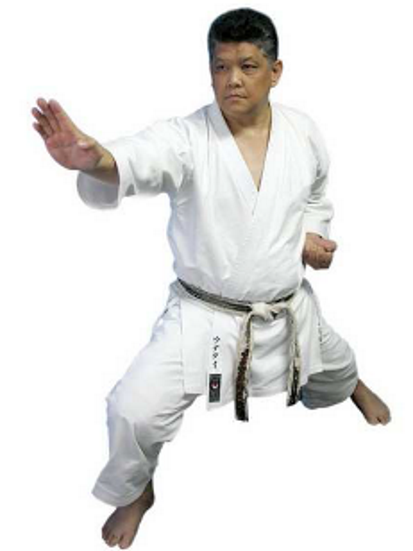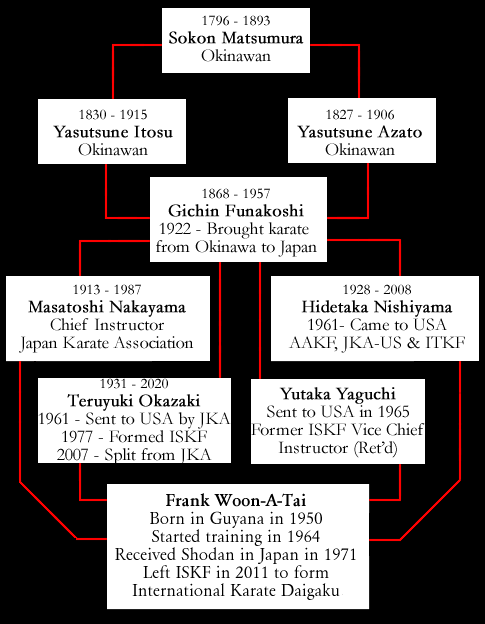About Us
The International Karate Daigaku is the newest and fastest growing International Karate Organisation. Since forming in February 2011, the IKD has grown to include 57 regions in 33 countries World Wide. This is inpart to the leadership of our Shihan Kai and our Founder Shuseki Shihan Frank Woon-A-Tai.
The International Karate Daigaku Association Australia (IKD-Australia) was established on the 1st of April 2017 by Hamid Mostofi Zadeh and is open to new members.
IKD Gympie Honbu Dojo is the first independent IKD Club in Australia that from 1st of April 2017 on has direct affiliation with the International Karate Daigaku (IKD) in Canada.
International Karate Daigaku Association Australia (IKD-Australia) provides traditional karate training (non for profit) for the community and its families. Karate training is healthy for everyone and every age group. It improves people self-confidence, spirit, focus, concentration and physical health and is ideal for learning self defence. We want to involve more people and children in sports/ self defence.
IKD-Australia is also a member of the Australian Karate Federation (AKF), Queensland Karate Association (QKA), World Karate Federation (WKF) and Oceania Karate Federation (O.K.F) which enables us to compete on state, national and international level in conjunction with our traditional art.
We practice authentic traditional Japanese Karate as taught by Gichin Funakoshi, the Father of Modern Karate.
We run classes to cater for all age groups, from beginners to advanced, junior to senior. The minimum age is 5 years and there is no maximum age. People who train regularly in karate develop improved motor skills, balance, self awareness, confidence, self defence and above all a great level of fitness. Karate training is widely known as the best form of all-round fitness.
All dojo instructors are fully trained in the latest training methods, using correct bio-mechanical principles. All dojo students are members of the International Karate Daigaku and all grades are registered in IKD- Headquarters Canada. Black belts can qualify as registered instructors, referees and grading examiners.
For further information, please contact us.
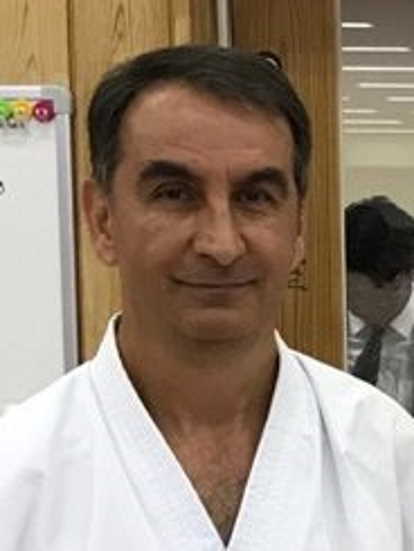
Hamid Mostofizadeh
He is the holder of:
- Chairman & Chief Instructor of IKD Australia
- Shichi Dan (7th Dan)
- Judge A, Instructor A & Examiner A license
- IKD Shihan-kai with IKD AAA credentials.
- Australian Karate Federation NCAS Gold Coach
- COVID-SAFE Coach
- Karate Queensland State Coach
- Karate Queensland Grant Officer
- Active After School Care and Community Coach with the Australian Government
- Blue Card holder for child related employment
- First Aid certificate
Hamid also holds accreditation as an Active After School Care and Community Coach with the Australian Government.
He is a Blue Card holder for child related employment.
He holds an up to date First Aid certificate (Australian government).
The Aims of IKD-Australia
- To teach traditional karate.
- To allow access to the best instruction and competition.
- To have all dan grades registered with the IKD headquarters.
- To allow members to qualify as IKD instructors, examiners and referees.
- To help students and instructors achieve their goals within karate.
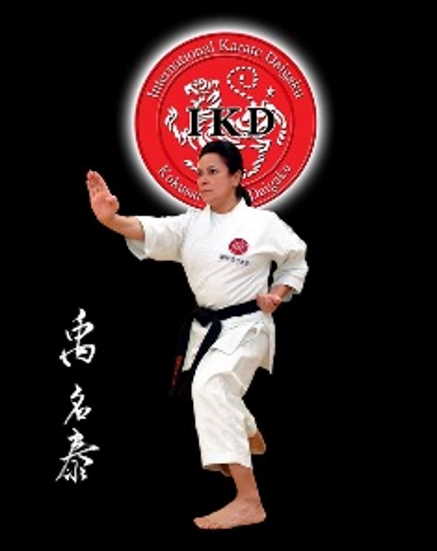
- To maintain and develop the connection with IKD headquarters.
- To prevent racial, religious, sexual or political discrimination among practitioners of karate.
- To communicate or affiliate with or enter into relationships with other organisations, associations, bodies and societies whether in Australia or outside Australia in such a way as to further develop the interests of karate.
FAQ
Do female students practice together with the male students?
Do you provide cardio vascular exercises?
How flexible do I need to be?
How often should I practice?
Is there any meditation in the training?
Do you teach any weapons?
Do you teach any throwing and/or joint techniques?
Will the training of Karate apply to any other martial arts?
How effective is the training at your dojo with regards to self-defense?
What is IKD?
IKD is an International Karate Daigaku organization that this studio is affiliated with. You can get more information at the IKD page and by accessing other links at the Links page
What benefits do I get from training in Karate?
Please consult our Training page for more information.
How is IKD Dojo of Australia different from other Karate studios?
Are the instructors at this studio experienced and qualified?
How much does it cost to train in Karate?
This information can be found at the Membership & Fees page
I am a complete beginner and I do not know any technique and customs. How will you teach me?
We practice in a group so a novice will get lost if he/she is thrown into such training at the very beginning. Therefore, a new student will receive private lessons by a black belt to learn the basic techniques and common etiquette and customs. After a new person has learned enough to follow what the group is doing, he/she will be asked to join the group training. Even in a group situation, the class instructor will pay extra attention to the new student to make sure he/she is following the instructions. In addition, one of the black belts will be assigned as a big brother/sister student to assist you.
Do you actually hit or kick each other during a sparring practice?
No, we practice non-contact Karate. With blocking techniques our arms may come into contact with each others, but the punches and kicks are delivered and completed before hitting a target. It takes a lot of practice to be able to control ones attacking technique; therefore, the novice will not be involved in sparring training for a few months. A student will not be doing any free sparring until he/she becomes a black belt. Below the black belt level, students will practice only the closely managed fixed sparring (read Training for more information about sparring).
I belong to another traditional Karate organization. Can I belong to your dojo?
Yes, IKD is open to anyone with any traditional Karate experience and affiliation.
How soon can I become a black belt?
That depends heavily on how often and seriously you train. You could reach that level in 2 to 3 years if you train often and consistently. However, it could also take you 10 years or longer if your training is not consistent. Regardless, the true aim of Karate training is not to just become a black belt even though there is no harm to have a goal. At Shodan (first degree black belt), that is where we consider real Karate training begins.
I have a black belt from another studio. Can I wear it?
I am 65 years old am I too old to join?
Do you have any children’s program?
At what age can a person join IKD Dojo of Australia?
Do you have a program for people who use wheelchairs?
Do you give private lessons?
HISTORY
It is said that karate goes back 5000 years and one of the first masters and pioneers of this art is Boudid Harama who lived in 525 B.C. He was a religious leader who first gained knowledge of the sciences of his time and then decided to teach religious belief to others. In order to do this, he started his journey alone from India and after walking for thousands of kilometers and passing through many challenges of nature arrived in China and took residence in a Shaolin temple in the state of Hunan. His teachings included extreme discipline and abstinence. He was in solitude and contemplation for 9 years while in caves and mountains.
In order for his students to be able to endure long hours of contemplation and also confront aggressors, who saw religious men and their beliefs as a burden to them, he created 18 moves which in reality constitute the foundations of today’s karate.
On the other hand, when Chinese dictatorships such as the Kink and Satsuma dynasties in Okinawa, sought to prevent the empowerment of their opponents and also to control people, they made the use of swords illegal and confiscated weapons used in martial arts. Because of this, people turned to combat trainings in which no weapons were used and this caused karate to become ever more popular.
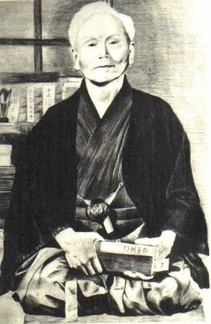
In 1921, one of the famous karate masters of Okinawa by the name of Gichin Founakoshi managed to introduce karate to Japan with a powerful and delicate approach. Some of the other students, who had been trained by the greatest masters of Okinawa, combined traditional techniques and created numerous karate styles. At the present time, karate practice consists of hundreds of different styles, all of which are rooted in the following four main styles:
Shotokan – The founder of this style is Gichin Founakoshi (1868 – 1957). Shotokan means house of Shoto (Founakoshi’s nickname) and “kan” means house. Shotokan belongs to the Shouri-Ne karate system.
Shito-Ryu – The founder of this style is Kanawa Maboni (1889 – 1952). This style consists of two karate systems: Naha-Ne and Shouri-Ne. Shito is derived from the names of two great masters from Okinawa, such that Shi comes from the name Anko-Itoso who is the undisputed master of the Shori-Ne system and to comes from the name Kanryo-Higauna who is the founder and grand master of the Naha-Ne system.
Guju-Ryu – This style was founded by Miagi-Choujoun (1888 – 1953). It means the hard and soft style and was formed in Okinawa and belongs to the Naha-Ne karate system.
Wadu-Ryu – The founder of this style is Hironouri Onsoka (1892 – 1982). It means the peaceful way or the peace-seeking method.
Gichin Funakoshi & Masatoshi Nakayama
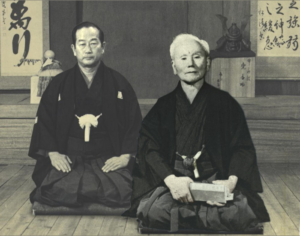 Gichin Funakoshi, The Father of Modern Karate was born in 1868 in Naha City, Okinawa Prefecture. He was the son of a Samurai who started training in the Martial Arts as a young man to help overcome his frailness. He became the Chairman of the Okinawa Shobukai in 1913. Funakoshi was a school teacher and a poet who wrote under the pen name of “Shoto”. From 1924 until his death in 1957, he travelled around Japan teaching karate at many Universities. He wrote several books on Karate including his autobiography, Karate-Do: My Way of Life , which was completed shortly before his death.
Gichin Funakoshi, The Father of Modern Karate was born in 1868 in Naha City, Okinawa Prefecture. He was the son of a Samurai who started training in the Martial Arts as a young man to help overcome his frailness. He became the Chairman of the Okinawa Shobukai in 1913. Funakoshi was a school teacher and a poet who wrote under the pen name of “Shoto”. From 1924 until his death in 1957, he travelled around Japan teaching karate at many Universities. He wrote several books on Karate including his autobiography, Karate-Do: My Way of Life , which was completed shortly before his death.
Masatoshi Nakayama was born in 1913 in Yamaguchi Prefecture. He is considered one of Master Funakoshi’s greatest students. Master Nakayama wrote many books on Karate included the Best Karate series. He helped to develop the JKA and served as the chief instructor from 1955 until his death in 1987. During his time as director of the JKA his goal was to spread karate around the World. He was extremely successful. Shotokan Karate is the most widely practiced form of Karate on the planet.
Our Style
The International Karate Daigaku (IKD) will use traditional and modern applied research to offer the highest level of karate to all students. IKD will uphold standards of excellence that inspire our students to improve character development and instil core values of respect, honour and discipline.
The IKD will also encourage positive behaviour and empower children and youth to live socially and emotionally healthy lives. The philosophy of karate will also be merged and aligned with culture and education to reflect the environment within which we live. It will help us understand ourselves and each other.
The end result is to have karate at the heart of all communities and promote peace, thereby preserving the well-being of humanity.
Nakayama & Woon-A-Tai

In the early 1970s, Master Frank Woon-A-Tai trained in Japan receiving his 1st Degree Black Belt from the Japan Karate Association in 1971. During his time in Japan, he had the opporunity to train with many famous karate masters including Grand Master Masatoshi Nakayama.
Okazaki & Woon-A-Tai

Master Frank Woon-A-Tai would continue his training as part of the ISKF under the leadership of Master Teruyuki Okazaki, 10th Dan and Master Yutaka Yaguchi, 9th Dan. Both men trained under Masters Gichin Funakoshi & Masatoshi Nakayama.
Yaguchi & Woon-A-Tai

While part of the ISKF, Master Frank Woon-A-Tai served as co-Chairman of the ISKF Technical Committee with Master Yutaka Yaguchi, 9th Dan.
Shotokan Tiger
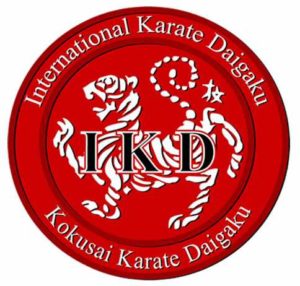 Gichin Funakoshi’s pen name Shoto literally means pine waves, and today is synonymous with the tiger symbol and Shotokan Karate-do. But few people understand the relationship of Shoto to what is commonly known as the Shotokan Tiger. When Gichin Funokoshi was a young man, he enjoyed walking in solitude among the pine trees which surrounded his home town of Shuri. After a hard day of teaching in the local school and several more hours of strenuous karate practice, he would often walk up Mount Torao and meditate among the pine trees. Mount Torao is a very narrow, heavily wooded mountain which, when viewed from a distance, resembles a tiger’s tail. The name Torao in fact literally means tiger’s tail.In later life, Funakoshi explained that the cool breezes which blew among the pines made the trees whisper like waves breaking on the shore. Thus, since he gained his greatest poetic inspirations while walking there, he chose the pen name of Shoto, pine waves.
Gichin Funakoshi’s pen name Shoto literally means pine waves, and today is synonymous with the tiger symbol and Shotokan Karate-do. But few people understand the relationship of Shoto to what is commonly known as the Shotokan Tiger. When Gichin Funokoshi was a young man, he enjoyed walking in solitude among the pine trees which surrounded his home town of Shuri. After a hard day of teaching in the local school and several more hours of strenuous karate practice, he would often walk up Mount Torao and meditate among the pine trees. Mount Torao is a very narrow, heavily wooded mountain which, when viewed from a distance, resembles a tiger’s tail. The name Torao in fact literally means tiger’s tail.In later life, Funakoshi explained that the cool breezes which blew among the pines made the trees whisper like waves breaking on the shore. Thus, since he gained his greatest poetic inspirations while walking there, he chose the pen name of Shoto, pine waves.
The tiger which is commonly used as the symbol for Shotokan karate is a traditional Chinese design which implies that the tiger never sleep. Symbolized in the Shotokan tiger, therefore, is the keen alertness of the wakeful tiger and the serenity of the peaceful mind which Gichin Funakoshi experienced while listening to the pine waves on Tiger’s Tail Mountain.

